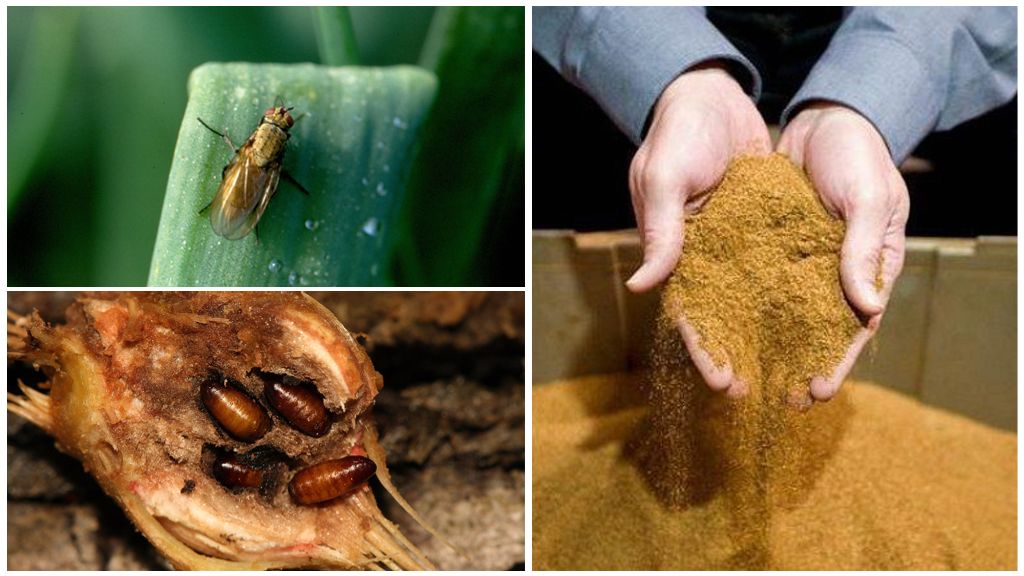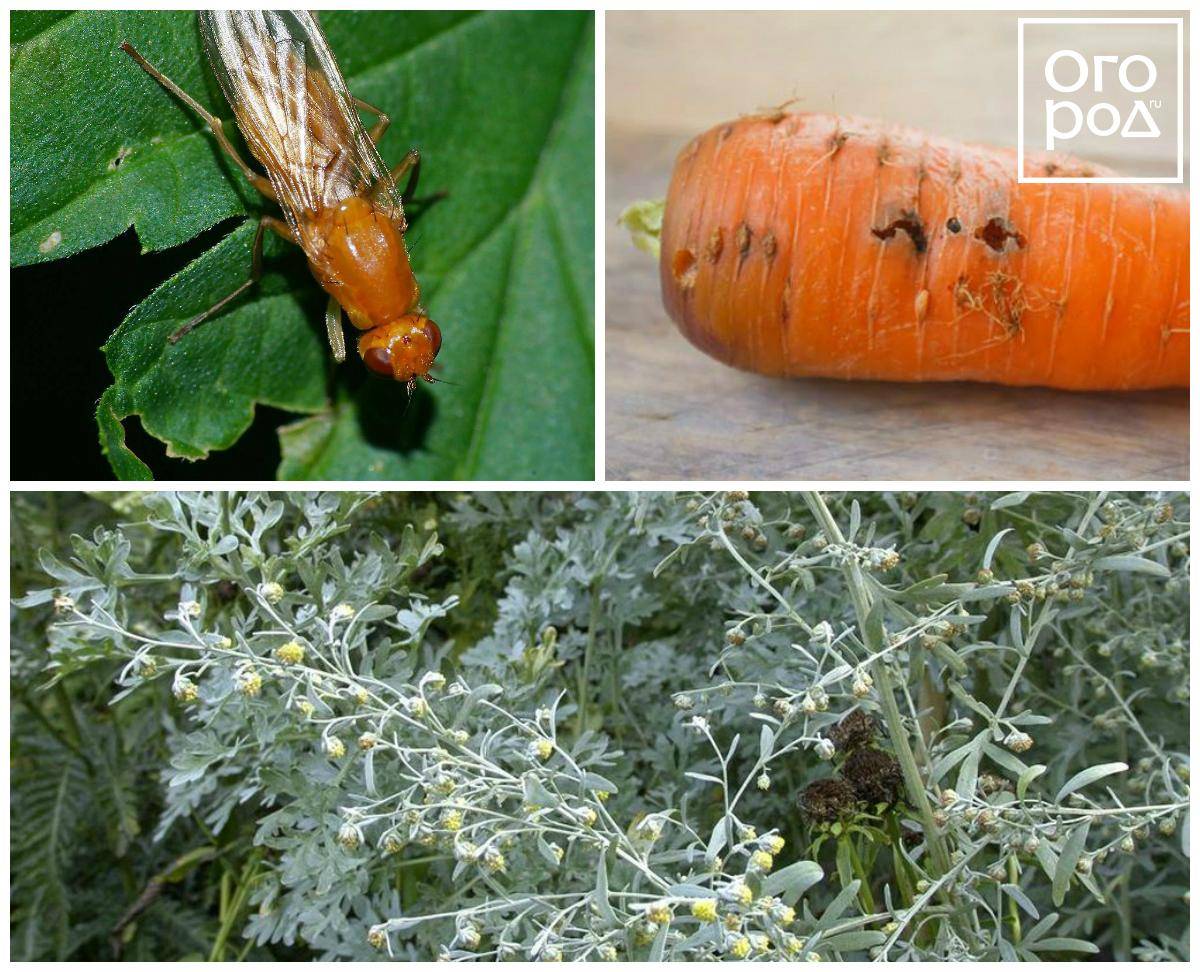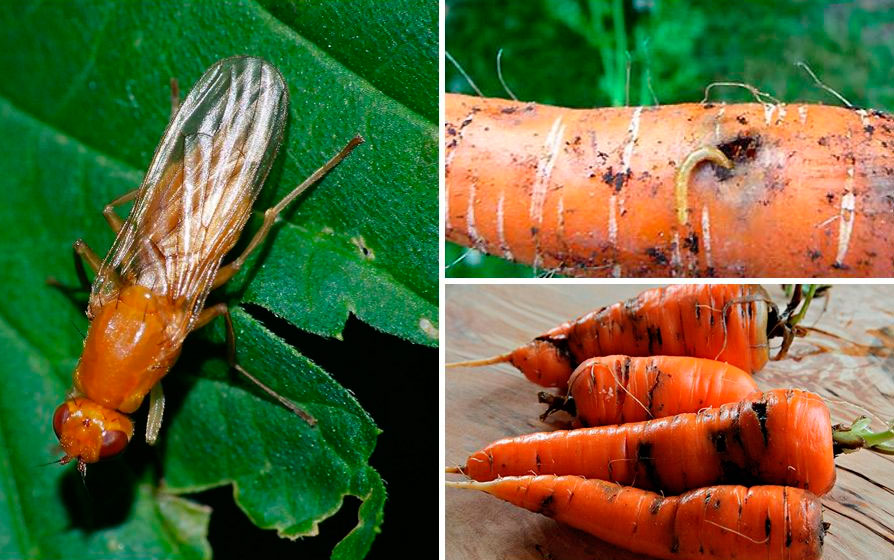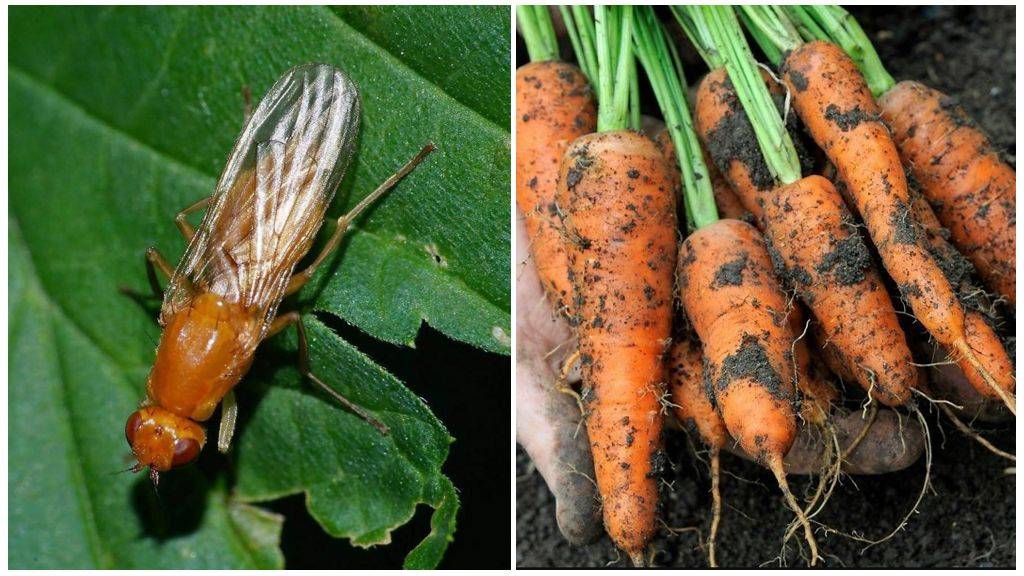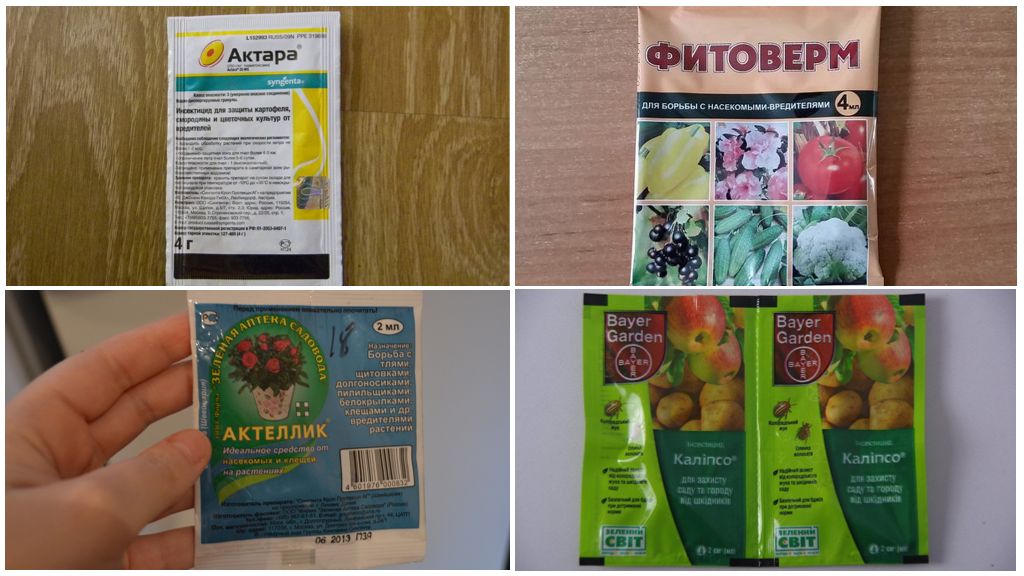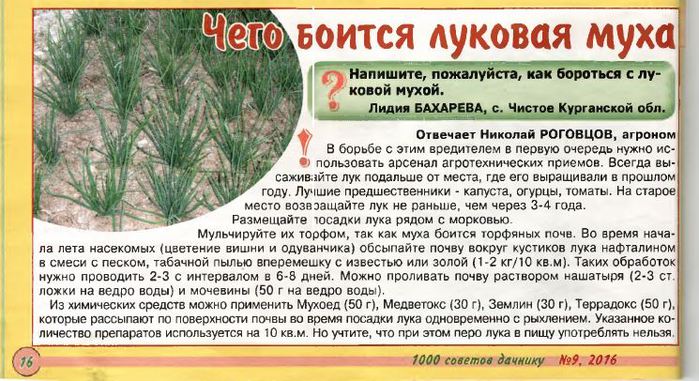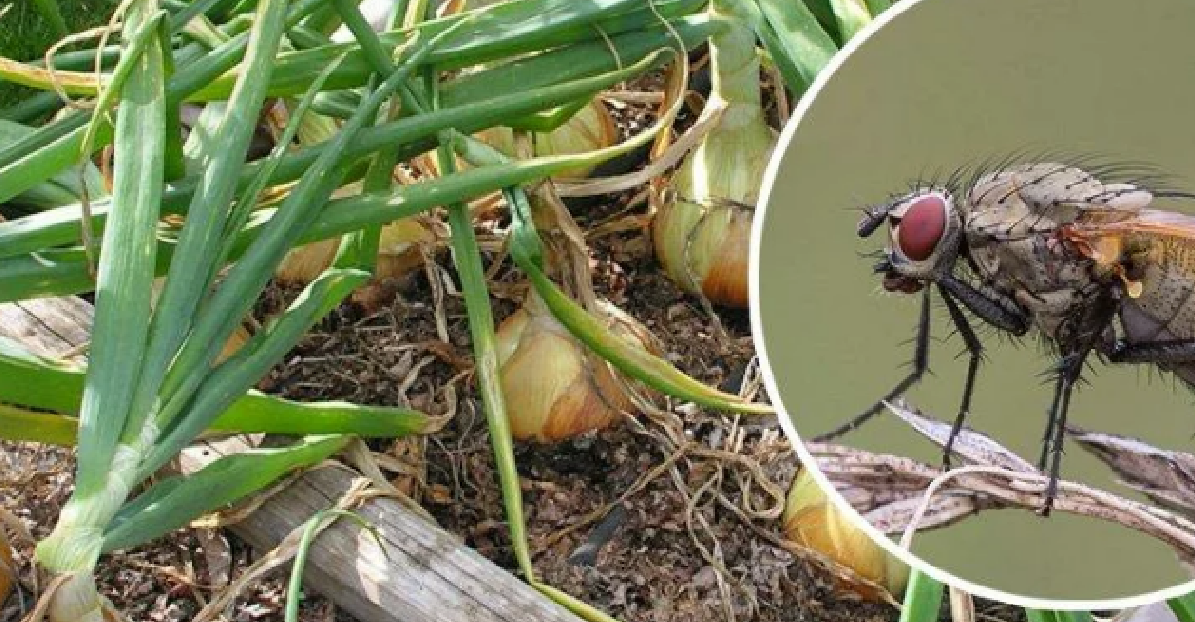How to deal with onion fly with chemicals?
Modern means for getting rid of garden parasites do not contain substances that contribute to the accumulation of chemicals in the fruits and leaves of treated crops. For people who go to summer cottages once a week on weekends, these drugs are much more profitable and attractive, because they act on parasites quickly and completely.
It is important to follow the prescribed instructions. List of the most effective insecticides against onion fly:
List of the most effective insecticides against onion fly:
- "Tarantula" is a powerful agent that acts through the digestive system of the larvae, which quickly die without developing into adults. Effective for three weeks;
- "Aktara" is a sprayer with a wide spectrum of action, including against onion flies. Destroys hidden larvae in the lower parts of the plant. Economical and efficient;
- "Extraflor" - created on the basis of tobacco extract, allows you to get the most environmentally friendly harvest. Lasts for two weeks;
- "Zemlin" is a product that is introduced into the soil when planting bulbous crops. Can be mixed with sawdust to reduce washout when watering.

Aktara is one of the most effective insecticides against onion fly
How to get rid of onion flies with folk remedies?
For those who live next to the garden, have the opportunity to regularly process plantings and are afraid to use "chemistry", there are other possibilities of how to defeat the pest on their own plot.
Traditional methods of dealing with onion fly are time-tested, non-toxic in most cases, are gentle with respect to plants and the consumer. But the expenditure of time and effort when using such funds often does not pay off, because the larvae die, but protected pupae remain, which again and again give generations of onion flies, and the cycle is constantly renewed. It is possible to use them only if the fly has not yet had time to breed enough.
How to treat crop beds from an onion fly:
- saline treatment is a fairly effective method. As soon as the bulb gives the first 3-4 feathers, the beds are watered with water in which table salt is dissolved in a proportion of 3 parts of salt to 10 parts of water. Re-processing is carried out after 2 - 2.5 weeks, with a more saturated solution: for 10 liters - 450 grams of salt. The third time, again after the same period of time, 6 parts of salt are taken to 10 parts of water. The disadvantage of this method is the strong soil salinity and loss of its quality;
- potassium permanganate solution - used for soaking onion sets before planting, as well as for subsequent watering. It should be pink;
- it is useful to mulch beds with onions with loose peat - the fly cannot lay eggs in soft, lumpy soil;
- when watering the beds with water with a suspension of ash, not only onion flies, but also other pests fly away;
- sprinkle onion plantings with a mixture of ash, mustard, tobacco and red pepper, or each of these substances separately. The disadvantage of this method is that the mixture is easily blown away by the wind and washed off by rain, so it can be used only during the beginning of the insect's flight;
- planting onions mixed with carrots is a well-known way to ward off onion flies, which are deterred by the specific aroma of carrot tops. And the carrot fly, by the way, avoids the smell of onions;
- after harvesting, deep digging of the soil is required in those places where onions were grown. Pupae and larvae of an onion fly, pulled to the surface, will die from the cold. It is recommended to plant onions on the same beds again no earlier than after 3 years.
Saving the harvest of onions
Every gardener knows his own method of getting rid of an onion fly. To completely cleanse the area from this insect, a whole range of measures is required. To do this, you need to know what the onion fly is afraid of. Consider what can scare an onion fly away:
- the smell of kerosene;
- the smell of naphthalene;
- the smell of tar;
- the smell of carrot tops;
- and etc.
Using these tools in conjunction with others, you can defeat the pest. Below are some folk remedies for onion fly. These are recipes that have been proven over the years.
Salt application
Salt not only repels flies, but also benefits the soil. During the season, at least three treatments are required:
- At the sprouting stage, at least five centimeters - a third of the pack in a bucket of warm water.
- Two weeks after the first irrigation - half a pack per bucket.
- After 21 days, another saline disinfection - two-thirds of the pack per bucket.
Do not water with salt water from a watering can, only spraying is permissible in order to avoid excessive salinization of the soil. Sprinkle with plain water 3-5 hours after processing to remove salt from the onion feathers.
Use of tobacco and wood ash
A very effective remedy:
- tobacco or tobacco dust - one teaspoon;
- ground red pepper - one teaspoon;
- wood ash - one glass.
Everything mixes, and with this you pollinate the garden.
Weeding must be done next.
There are several more options for processing onions from an onion fly:
- You can sprinkle the bed with a mixture of tobacco dust and ash (1: 1). Repeat the treatment for a month every week.
- It will help, as a remedy for onion flies, and a mixture of the same tobacco dust with ash from a sunflower (1: 1). Use as soil pollination. In addition, sunflower ash is an effective potassium-magnesium fertilizer that reduces the acidity of the soil (a glass of ash for a bucket of water). Whether tobacco dust from onion flies helps, the gardener himself decides.
Salt and kerosene use
Kerosene
This treatment is done in the spring, before planting onions:
- a bucket of warm water;
- kerosene - two tablespoons;
- salt - half a glass.
Stir well and shed the grooves prepared for planting. For what? What do many vegetables like, including onions? That's right, a little salt in the soil.
The use of iodine and boric acid
A tool proven over the years:
- a bucket of water;
- boric acid - half a teaspoon;
- iodine - three drops;
- potassium permanganate - slightly, to pink water;
- technical ammonia - five tablespoons.
To stir thoroughly. Without being lazy, pour about a small cup under each root.
Application of insecticides
Of course, folk remedies for pest control are proven and environmentally friendly. But, sometimes, they do not give the expected effect. And against his will, the gardener resorts to the use of so-called "harmful" chemicals. It showed itself well in the fight against the onion fly "Alatar", which needs to be sprayed with plants during the growth period. And irrigation with "Intavir" also scares away the fly.
Some gardeners use the drug Metronidazole against onion flies. Many treat this negatively, but many do not consider its use in the garden dangerous and, diluting 5 tablets in a bucket of water, boldly water the onion beds. They do this once a season, when the feather has already grown stronger and will be at least five centimeters in height. Everyone has their own opinion on this matter. As they say, the owner is a master.
In the fight against the real enemy of onion plantings - the onion fly, all non-dangerous means are good!
Folk remedies
 Folk recipes for fighting onion fly
Folk recipes for fighting onion fly
To destroy the pest in the garden, substances with a fly-repelling smell are used. The processing of the culture is carried out by spraying, watering, some funds are crushed in the beds between the rows.
Watering with salt
The easiest and most accessible way to fight. For 10 liters of cold water, you need a glass of table salt.Stir thoroughly, watered with the calculation of 1 glass of solution for 1 plant. To prevent salting of the soil, the next day, repeat abundant watering, but with plain cold water. The saline solution is used once every 14 days.
Ammonia
Fighting with ammonia is just as easy. For 10 liters of cold water, 3 teaspoons of ammonia are consumed. You need to prepare the solution immediately before use.
Water the ammonia solution in such a way that it does not fall on the feathers. The method will not only help to protect the onion from pests, but also accelerate the growth of greens, the formation of the bulb. A solution of chicken manure, which also contains ammonia, works similarly.
Tobacco dust
To remove the larvae, to scare off the onion fly, tobacco powder or cigarette butts can. Scattered over the garden, sprinkle tobacco dust on the pre-moistened soil. You can also withdraw with tincture, decoction. Cigarette butts or tobacco are poured with cold water, insisted for a day. Water the onions in the evening or early in the morning. Repeat after 3 days. To prepare the broth, a fresh plant is used, poured with boiled water, boiled for a minute, insisted for a day.
Wood ash
Wood ash can save onions and increase yields. It is one of the most effective means in the fight against many pests. Sprinkle the beds with powder. The action is enough for 1-2 weeks, depending on the layer. The solution can be sprayed on the beds, the green part of the plant, to process the soil before planting the seedlings and after harvesting on the site. Ash, a little laundry soap are added to a bucket of water. Pour into a household spray bottle or spray bottle. Ash penetrates into the juice of the culture, makes it bitter for the larvae, and also irritates the skin upon contact.
Prevention of the appearance of onion flies
Insect attacks can be avoided by applying a number of measures familiar to every grower and vegetable grower.

- Observance of crop rotation - you cannot plant one crop in one place for many years in a row, onions are alternated every 3-4 years.
- The bulbs before sowing (at home and in the garden) are treated with either a manganese solution or a commercially available fungicide. The same applies to material left for winter storage.
- For domestic bulbous plants, there is a rule for disinfecting the soil, for a garden it is mandatory cleaning of all plant residues and deep digging. Insect larvae calmly overwinter in the bark or forgotten bulbs, and eggs can also be in a non-sterile substrate.
- In the beds, repellent plants will help prevent the appearance of pests - these are wormwood, marigolds, planted in the aisles. The smell of repellents scares off the onion fly, and accordingly avoiding visiting such plantings, it will not postpone offspring.
- A good protective tandem is carrots and onions, planted nearby. Experienced gardeners have noticed that the carrot fly cannot stand the smell of onions, and the onion fly does not like the smell of carrots. It is necessary to plant crops in a row, since they have different watering frequencies.
- Effectively repels insects and prevents offspring from postponing pine needles mulch, placed on the beds immediately after the first shoots appear.
Did you know? The fly flaps its wings at a speed of up to 200 times per second, and a buzzing sound during flight emits a pair of elongated processes located behind the wings.
Getting rid of an insect in the garden and in the apartment is not so difficult. But it is still better to prevent its appearance than to treat the affected plants.
Fighting onion fly folk remedies
Greetings, dear friends!
Onion fly is the main pest of all onion crops (leeks, onions for turnips, garlic, flower bulbs). In May, pests that have overwintered in the soil fly out to lay eggs, from which larvae emerge after a week and penetrate into the plant bulbs.
The pests become active for the second time this season in July. From larvae pupated in the soil, flies of the second generation fly out and again cause irreparable harm to the plantation.Fly-affected seedlings are characterized by drying out of the aboveground part and rotting of the bulbs in the ground.
Crop rotation rules and joint landings to combat onion fly
To avoid the onion fly invasion when cultivating onions, you should follow the rules of crop rotation. Onions are returned to their original place no earlier than after 2-4 years. During this time, the soil is naturally freed from the larvae of the pest and is ready to accept the plants. The culture is not planted after the garlic.
Mixed plantings of onions and carrots have proven themselves well. Plants are planted across a row on the same plantation or beds are set up side by side. The phytoncides released by onions into the soil and air scare away the carrot fly, and the sharp aroma of carrot tops does not allow the onion fly to locate the culture it has chosen.
Marigolds planted around the perimeter or at the ends of the onion beds will help scare the fly away from the plants. Essential oil and other volatile compounds released into the air by a flower crop eliminate the pest, masking the attractive aroma of onion tops. Marigolds are planted simultaneously with onion sets or nigella.
The most effective ways to deal with onion fly
According to the reviews of experienced vegetable growers and fans of organic farming who do not use chemical insecticides on their site, there are a number of effective measures using improvised means to prevent the onion fly from settling in the plantation.
Ash against onion fly
Plant ash is an ideal fertilizer for planting onions. In addition, the high concentration of alkali and a set of trace elements in the ash have a depressing effect on onion fly larvae. In order to prevent the invasion of pests, onion breasts are regularly sprinkled with ash, evenly distributing the composition over the soil surface around the plants and in the aisles.
The first time dusting with ash is carried out 1-2 weeks after the appearance of mass shoots (April-May). The event is performed in dry weather, 2-3 hours after scheduled watering. It is desirable that no precipitation be observed in the next 1-2 days. The frequency of treatments is every 2 weeks. The last application of ash is carried out 3 weeks before the harvest of root crops.
A mixture of ash with tobacco dust and bitter ground pepper (chili) has proven itself well against onion flies. For 300 grams of ash, 3 tablespoons of tobacco and 3 teaspoons of red pepper are taken. This portion of a biological insecticide designed to repel onion flies is enough to treat three square meters of plantings. It is recommended to dust the soil surface with a mixture twice with an interval of 10-17 days.
Table salt against onion flies
Treating the beds with saline is another productive method for preventing pest infestations. To prepare the solution, dissolve 1 glass of sodium chloride crystals in a standard bucket of water. Watering is carried out at the root, avoiding the composition getting to the tops (feather).
The first time the procedure is performed when the pen reaches a height of 4.5-5.5 cm. The second treatment is done after 3 weeks. The third time, the saline solution will be required a month before the bulbs are excavated (July).
Some gardeners, instead of watering with saline, use dusting the plantation with a mixture of salt crystals and baking soda (2: 1). You can alternate pollination of the soil with salt with soda and ash with tobacco dust (1: 1).
All these methods have long been tested on numerous household plots. The successful fight against onion fly with folk remedies helps to annually minimize the harm caused to onion plantings by the larvae of this pest. Bountiful harvests for you every season! See you!
Spied on by nature
All living organisms are afraid of smoke and try to avoid it. This well-known fact is the basis for the use of a repellent preparation "Sochva Zh" - an aqueous concentrate of liquid smoke.

"Sochva Zh" has been tested by specialists from the Research Institute of Agriculture of Khabarovsk and is recognized as an effective means for repelling insects.

The repellent is valid for 2 weeks. Despite the environmental safety, you should carefully read the instructions for use.

The reality is that just planting a bed of onions, occasionally watering and feeding it, is not enough.

-
Tomato cladosporium disease - what is it and how to deal with it in greenhouses? 69 photo ideas
-
Treatment of tomatoes (51 photos): fungus, viruses, cladosporiosis, fusarium, macrosporiosis and other diseases
-
Ants in a greenhouse (65 photos): how to get out quickly and safely? Tips, instructions and recommendations
It is difficult to get a rich harvest in this case.

An invisible army of pests acts against gardeners on the ground and in the air, victory over which is impossible without observing the rules of agricultural cultivation and protection.

Onion fly - description
What does an onion fly look like? This flying insect is light gray in color, about 1 cm long. Males differ from females only by the presence of a dark stripe on the abdomen. Females of flies are fertile: during their life they are able to lay up to 60 white eggs with a longitudinal stripe up to 1 mm long.

Onion fly
The years of onion flies begins early - in April. Pests lay their eggs on the leaves of onion crops or on bulbs protruding from the ground. After 5-8 days, the onion fly larva emerges from the egg, which immediately penetrates into the pulp of the onion and feeds on it, and after 2-3 weeks the larva becomes an adult insect. In one season, onion beds can be attacked by two to three generations of onion flies.
As a result of the vital activity of the larvae, the heads of the bulbs soften and become unsuitable for food. Failure to kill flies before they lay eggs could result in a significant loss of crops. The presence of an onion fly in the garden can be determined by the following signs:
- the growth and development of plants slow down;
- onion feathers break and turn yellow prematurely;
- an unpleasant odor emanates from the plant;
- the bulbs become soft and rot;
- under the upper scales of the bulb, you can see swarming worms;
- plants rot or dry out completely.
Preventive measures
Prevention measures are aimed at preventing plant contamination. The main recommendation is to change your bow seat every three years. Before planting, onion seedlings should be soaked for ten minutes in a heated solution of potassium permanganate. At the end of spring, it will not be superfluous to treat the soil with insecticides.
In addition, fertilizer mixtures based on peat, manure and peat must be applied to the soil. To prevent the midge from approaching the plantings, the seedlings should be treated with bitter compounds based on wormwood, tansy or pepper. After harvesting, the soil must be dug up so that the larvae die from the cold.
p> Share link:
Differences between the onion fly and other arthropods
In order not to let the onion fly spoil the crop, it would be nice to first find out how it looks and how it differs from other insects.
The length of the onion fly (Latin name Delia antiqua) reaches 8 mm, its body is painted in gray-yellow tones. Its distribution area covers many southern regions, as well as areas belonging to the temperate zone. People who grow vegetables are forced to spend energy and money to fight this pest.
The onion fly itself is a harmless creature if it did not produce voracious larvae. During her short life, each female lays about 50 eggs. The egg-laying site can be found in the protruding parts of the bulbs. In one separately taken onion of such eggs, there can be from 10 to 20 pieces.
Fly eggs are white, elongated in shape, and do not reach 1 mm in diameter. It is easy to find a furrow running along the eggs.From this furrow, you can immediately understand that the eggs belong to this particular pest.
The onion fly is mainly interested in onions, as, for example, the carrot fly is more interested in carrots, however, it is able to lay eggs in the bulbs of other plants:
- garlic;
- onion;
- Tulip;
- leek.
The larvae hatch 7 days after oviposition. They are very similar to earthworms, but only they are significantly inferior to them in size. The length of the larva does not exceed 10 mm; the body is more narrowed in front than in the back.

From 10 eggs laid in one bulb, the larvae are born almost simultaneously. Immediately after birth, they gnaw the flesh of the bulb so that a cavity appears in it.
The larvae feed intensively for 3 weeks, and then relocate to the soil, where they soon pupate. From the day of pupation, it will take about 3 more weeks for an adult onion fly to emerge from the pupa.
The onion fly damages bulbous plants throughout the season. The first time the fly makes egg-laying in April, then in July the 2nd generation of these parasites appears. In warm areas, the female manages to give 3 or 4 generations during the summer. Pupae overwinter in the earth, deepening by 20 cm or more.
Ways to deal with onion fly in the garden
Ways to combat onion fly in the garden:
- Treatment with chemical insecticides, which guarantees a quick result, but adversely affects the condition of the soil and can cause poisoning or allergic reactions.
- Folk remedies that are safer and more environmentally friendly.
- Agrotechnics. Its rules are scientifically substantiated and confirmed by the experience of many generations. Neglecting them increases the risk of re-infestation and reduces onion yield. For example, the requirements for soil looseness, planting density and moisture balance provide for the creation of an unfavorable nutrient medium for reproduction and growth of larvae. An even dry crust is ideal for laying eggs.
- Crop rotation. Alternating onion and carrot plantings is a very effective way to control onion flies, which cannot stand the smell of carrots. Neighborhood with tomato or mint also minimizes the risk of injury. A gross violation of crop rotation is the planting of onions in the same place for two seasons in a row. The successfully overwintered fly larvae will wake up in the spring and continue to eat onions. For the same purpose, they dig up the soil in the fall in order to freeze the egg-laying.
Industrial insecticides
Professionals recommend using them as a last resort and with great care. The watery structure of the cell of bulbous cultures quickly accumulates toxic substances
The dosage of insecticides must strictly follow the instructions.
It is important to understand that only the complex use of several drugs at the same time guarantees getting rid of the onion fly. Onion fly insecticides:
Onion fly insecticides:
- Ammonium carbonate - combines insecticidal and anti-stress effects. Used as an immunomodulator. It copes well with the problem and is the least dangerous to humans.
- "Aktara", "Sochva", "Tabazol" - insecticides for the treatment of bulbs and soil through spraying. According to the reviews of professionals, they are highly effective. When using them, it is necessary to avoid getting the drugs on the onion shoots.
- "Medvedtoks", "Mukhoed", "Zemlin" are insecticides that are recommended to be applied to the soil when planting onions. This makes them safer to use.
- The complementary effect of the preparations "Intavir" and "Immunofitofit", which in the amount of ¼ and 2 tablets, respectively, are dissolved in 2 liters of water. The addition of tar or green soap to the solution will ensure that the insecticides adhere to the surface. A month later, the treatment is repeated at the same dosage, excluding "Intavir".
Folk remedies
Folk methods should be adopted by those who care about the ecological cleanliness of the crop and the health of their families.
Less pronounced effectiveness makes it necessary to regularly process the affected plants with folk remedies. The number of repetitions depends on the severity of the condition and can reach 3-4. However, patience is rewarded with a quality product.
Folk remedies for onion flies:
Salt. It is dissolved in water in a proportion of 1.5 tbsp. spoons for 10 liters of water. Then the garden is watered using the "sprinkler" nozzle, over the sheet. After an hour, the plants are watered a second time, but with clean water. Repeat the procedure every 10 days
It is important to understand that saline soil needs complex fertilizers.
Potassium permanganate solution. Manganese is effective due to its ability to disinfect the nutrient medium
The bulbs are immersed in a weak pink solution before planting. The aggressive environment of potassium permanganate neutralizes the larvae, which may be in the soil at the time of planting.
Dandelion root. For 7 days, 10 grams of dandelion rhizomes are insisted in 10 liters of water, after which they are irrigated weekly by sprinkling. The strong bitterness secreted by the roots repels the onion fly larvae.
Tobacco dust. It can be used both as a stand-alone product and in combination with lime. The solution is prepared in a proportion of 200 grams of bulk ingredients per 10 liters of hot water and infused for 2-3 days. The treatment is carried out by spraying the bulbs and soil in the aisles. Liming will be very beneficial for soils with high acidity.
Insecticidal plants. They have a pronounced and persistent odor, unpleasant for larvae and adults of the fly. These plants include lavender, wormwood, mint, junipers. Cut shoots and leaf mass are insisted in proportions similar to dandelion root.
Signs of the presence of a pest
The larvae of adult insects suck out all the juices from the bulb and devour the pulp. After three weeks, the flies completely destroy the plant, burrow into the soil and pupate. In this state, she spends the whole winter.
In the spring, the onion fly emerges from the cocoon weak, but capable of life. For a week she will feed on the nectar of dandelions or lilacs, and in another week the sexually mature period will come. At this time, insects move to the onion beds.
The following signs will help to notice pests on the vegetable garden in time:
- The bulbs begin to rot and give off an unpleasant odor. In the section, you can see the moves made by the larvae.
- The plant slows down in growth, the feathers begin to turn yellow, wither, the tips curl inward.
- The bulb is easily pulled out of the soil from the root, near the bottom you can see small worms, these are the fly larvae.

After harvesting, you need to dig deep into the ground (to a depth of 20 cm). How can pest infested soil be treated? The onion fly dies in a salty environment, so it is recommended to water the beds with a saline solution before planting the bulbs. The larvae die immediately.
How to get rid of an onion fly?
What is an onion fly, how to deal with it is not difficult to decide, the main thing is to take care of everything on time. It is not at all necessary to buy very expensive products - there are many methods that will help to cope with the misfortune. It is much easier to prevent the appearance of a pest, so it is worth listening to the advice of experienced gardeners.
Means of fighting onion fly in the garden:
If you plant onions and garlic near carrots, wild rosemary and tomatoes, then the onion fly will not touch them. Spraying
You can spray with broths of mint, valerian or pine needles, it is important to water, feed and loosen the ground on time. Disinfect the soil before planting onions
Solutions or copper sulfate will do. Treat with folk remedies or chemicals.
What does an onion fly look like?
To better understand what kind of creature the onion fly is, how to deal with it, you need to know how this pest "works". Individuals from one clutch are kept together and eat away the pulp in the onion, leaving a void. After a couple of weeks, the larvae burrow into the ground, turn into pupae, from which a new generation of onion flies soon appears.
Typical signs:
- gray-yellow color;
- length - 7-8 mm;
- on the wings - a fringe of bristles and stripes.
Flies do not directly harm, their larvae are engaged in this. Large individuals are dangerous because they lay a lot of them. They hatch from eggs for 3-5 days, and ripen for about 8 days. Pests fly out in late April - early May, and immediately begin to actively take care of the offspring, eggs are laid on bulbous beds or dried plant scales. In a lifetime, one female can lay 40-60 eggs.
Distinctive features of onion fly eggs:
- White color;
- length up to 1 mm;
- longitudinal strip along the egg.
What does an onion look like when struck by an onion fly:
- the onion grows slowly;
- green feathers turn yellow;
- there is a rotten smell;
- the bulbs become soft;
- cavities with larvae are formed inside and on the roots of the plant.
Onion fly chemicals
If the use of folk remedies does not bring the desired results and the pest continues to destroy the onion beds, you will have to resort to using insecticides. The list of drugs acceptable for use in this case includes:
- "Medvetoks", "Mukhoed", "Zemlin", which are based on diazinon. The preparations are introduced into loose soil when the bulbs are planted. After their application, the larvae die due to damage to the chewing and suction apparatus.
- "Aktara" - the active ingredient of the drug is thiamethoxam. Spraying with this drug can be carried out during the growing season. It affects the nervous system of pests.
- When using the drug "Karate Zeon", which contains lambda-cyhalothrin, the nervous system of insects is also destroyed. Can be used throughout the entire growth period.
- Sochva. This preparation contains a water-soluble substance obtained by burning wood.
Prevention
The first signs of the presence of a pest in the garden can be seen in the spring, when dandelions, cherries and lilacs begin to bloom. Flowers are essential for the development of insects. The fly feeds on the nectar of these plants.
The appearance of a pest is easier to prevent than to look for ways to deal with it later.

Preventive protection against onion flies can include a number of the following:
- it is better to plant onions next to a carrot or tomato bed (the fly cannot stand the smell of carrots and tries not to lay eggs next to this vegetable);
- onions should be planted as early as possible;
- it is impossible to plant onions in the same place for several years in a row (pests successfully winter in the soil, burrowing into the remains of plants);
- it is recommended to mulch the soil (rotted manure, hay, peat can be used as mulch);
- planting material must be placed in a disinfecting solution (a weak solution of potassium permanganate is suitable);
- before planting, it is necessary to fertilize the soil with peat or manure;
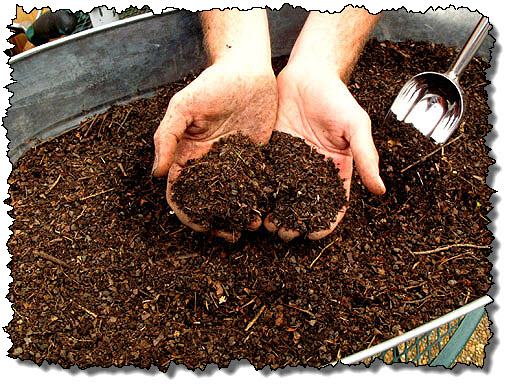
- the earth can be pretreated with saline, and after 5 hours it can be well shed with clean water;
- after emergence, it is useful to carry out preventive treatment with a bitter solution based on, for example, wormwood, pepper, tansy;
- after harvesting, you need to dig up the ground, the larvae on the soil surface do not tolerate cold weather and die.
It should be remembered that before using any solution, the soil must be watered! This will allow all components to operate safely and effectively. Some solutions require watering with clean water several hours after the procedure.
For the entire growing season, the onion bed must be properly and carefully looked after: weed on time, avoiding the growth of weeds, observe the correct watering regime and be sure to loosen the soil.




